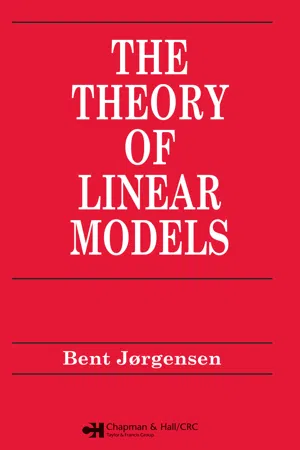
This is a test
- 240 pages
- English
- ePUB (mobile friendly)
- Available on iOS & Android
eBook - ePub
Theory of Linear Models
Book details
Book preview
Table of contents
Citations
About This Book
Providing a self-contained exposition of the theory of linear models, this treatise strikes a compromise between theory and practice, providing a sound theoretical basis while putting the theory to work in important cases.
Frequently asked questions
At the moment all of our mobile-responsive ePub books are available to download via the app. Most of our PDFs are also available to download and we're working on making the final remaining ones downloadable now. Learn more here.
Both plans give you full access to the library and all of Perlego’s features. The only differences are the price and subscription period: With the annual plan you’ll save around 30% compared to 12 months on the monthly plan.
We are an online textbook subscription service, where you can get access to an entire online library for less than the price of a single book per month. With over 1 million books across 1000+ topics, we’ve got you covered! Learn more here.
Look out for the read-aloud symbol on your next book to see if you can listen to it. The read-aloud tool reads text aloud for you, highlighting the text as it is being read. You can pause it, speed it up and slow it down. Learn more here.
Yes, you can access Theory of Linear Models by Bent Jorgensen in PDF and/or ePUB format, as well as other popular books in Mathematics & Probability & Statistics. We have over one million books available in our catalogue for you to explore.
Information
CHAPTER 1
Simple Linear Regression
Linear models are used for studying the explanation of a given variable in terms of a linear combination of given explanatory variables. In the present chapter, we discuss the case of one explanatory variable, as a preparation for the general case, which is treated in Chapter 2 and onwards. Readers already familiar with simple linear regression may want to go directly to Chapter 2, with occasional reference to Chapter 1 as necessary.
1.1 The linear regression model
Consider an experiment in which we make simultaneous measurements of two variables x and y for a range of different experimental conditions. If we make n measurements, let
denote the corresponding n pairs of observations. We construct a statistical model for the situation where the relationship between x and y is thought to be linear or approximately so.
Often x represents the experimental conditions, and y represents the outcome of the experiment. The variable y is called the response variable or the dependent variable. We assume that y1, …, yn are realizations of independent random variables Y1, …, Yn. In contrast, the values xl, …, xn are considered constant (non-random), and x is called the explanatory variable or the independent variable. We must hence make a clear distinction between the response and explanatory varia...
Table of contents
- Cover
- Half Title
- Title Page
- Copyright Page
- Dedication
- Contents
- Preface
- Chapter 1–Simple Linear Regression
- Chapter 2–The General Linear Model
- Chapter 3–One-Sample and One-Factor Analysis of Variance
- Chapter 4–Multiple Regression Models
- Chapter 5–Analysis of Residuals
- Chapter 6–Analysis of Variance With Two or Three Factors
- References and Bibliography
- Index